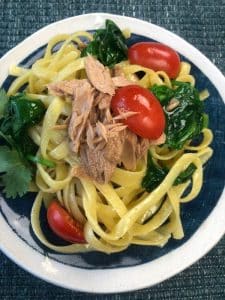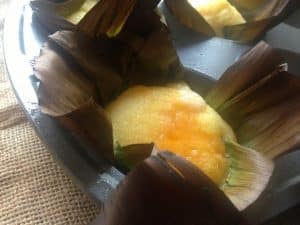Filipino Pork Menudo
As an Amazon Associate and member of other affiliate programs, I earn from qualifying purchases.
The Filipino Pork menudo is tomato-sauce based. As the meat and vegetables are sautéed the tomato’s tartness turn to a sweet flavored gravy. There is something in the dish for everyone. The uniformed cubes of pork, potatoes and carrots together with the crunchy garbanzos and sweet peas are appealing to all.
I cook my menudo with plenty of sauce to go around. Filipinos love sauce. The more sauce there is, the better to extend the dish. We love to pour sauce on a bed of boiled white rice, the steam floating out of it, a staple at every Filipino meal.
But there’s more to menudo. The Filipino menudo has a rich history all its own and it is quite interesting to know where this colorful entree originated from.
Three hundred years of Spain’s colonization influenced Philippine cuisine. Spanish dishes in the Philippines were influenced by Spain’s other colonies, primarily Mexico. From 1565 to 1815, the galleon trade between Manila and Acapulco enabled an exchange of goods and food between the two countries. What came from Mexico to the Philippines were tomatoes, potatoes, cassava, corn, peanuts, bell peppers, chilies and a variety of tropical fruits. The Philippines sent to Mexico mangoes, tamarind, rice and “tuba” (coconut wine). One result was that many common Filipino dishes came to our tables via Mexico.
Hundreds of years later, Filipino-American immigrants like me, bring with us the Filipino recipes we grew up with.
From Manila, my good friend and exceptional journalist Tracey Paska tells me the word “menudo” likely comes from menuts, the Catalan word for a Spanish dish of beef stomach and posole (hominy) in a spicy, chile-based broth.
Mexican menudo is a stew of tripe and white hominy. Filipino menudo, in contrast, has uniformly cubed pieces of pork, potatoes, calf’s liver, bell peppers, garbanzos or chick peas stewing in a thick, slightly sweet tomato sauce broth. In America, I omit the liver, an ingredient not always available in my nearby grocery.
Like other Filipinos, I cannot claim this recipe as uniquely mine. What I cook and what other Filipino-Americans cook in our kitchens is a menudo recipe that was passed around from the family, friends, chefs or just anyone who loves the ease and comfort this dish provides – for a fancy fiesta or a family meal. Whatever version one chooses to cook, menudo is the kind of dish that brings cultures together.
Filipino Pork Menudo
Equipment
- Large saucepan - 12 to 14-inches diameter
Ingredients
- 2 pounds pork shoulder or tenderloin cut into 1-inch cubes, fat timmed
- 1 Tablespoon soy sauce, Filipino brand like Silver Swan, or Chinese brands
- 1 Tablespoon lemon juice
- 2 Tablespoons extra virgin olive oil
- 4 cloves garlic peeled, minced
- 1 whole medium-sized onion, white or yellow, diced
- 1 cup chicken broth
- 1 can (8 ounces) tomato sauce
- 2 whole medium-sized potatoes, peeled, cubed into 1-inch pieces
- 1 whole large carrot, peeled, cubed into 1-inch pieces
- 1 whole red or green bell pepper seeded, white membrane removed, cut into 1-inch cubes
- 1/4 cup bread crumbs
- 1/2 cup chick peas (garbanzos), canned, drain liquid
- 1/2 cup frozen green peas
- 1/2 teaspoon sea salt
- 1/4 teaspoon freshly ground black pepper powder
- for serving: steamed rice
Instructions
- In a non-reactive medium-sized bowl, marinate the cubed pork with the soy sauce and lemon juice. Cover with plastic wrap and refrigerate at least 4 hours or overnight.
- Heat a large skillet over medium heat. Add the olive oil. When oil is hot, add garlic and onions and sauté until translucent.
- Drain and discard the marinade from the cubed pork. Add the pork pieces to the garlic and onions in the skillet. Cook 1 to 2 minutes,
- Add the broth and the tomato sauce. Stir to blend.
- Add the potatoes, carrots, green pepper and bread crumbs. Cover and cook for 10 to 12 minutes or until meat and vegetables are soft and cooked through.
- Add the chick peas and green peas. Cook for 1 to 2 minutes more. Season with salt and black pepper. Serve with boiled rice.
- Acknowledgement: Some references for the history of menudo and Spanish influence in Philippine cuisine were from "Memories of Philippine Kitchens" cookbook by Amy Besa and Romy Dorotan.
- Hello, Friends! All the images and content on this blog are COPYRIGHT PROTECTED and owned by my media company Besa-Quirino LLC. This means BY LAW you are NOT allowed to copy, scrape, lift, frame, plagiarize or use my photos and recipe content I wrote, on your website,books, films, television shows or videos without my permission. If you want to republish this recipe or content on another website, video, news article,or media outlets mentioned above please ASK my permission, re-write it in your own words and simply link back to this blog to give proper attribution. It’s the legal thing to do. Thank you. Email me at [email protected]
- Disclosure: As a participant in the Amazon Affiliate program, some blog posts contain links to products used in the recipe and sold on Amazon. The price stays the same for the readers who wish to purchase these products on my links. I earn a small commission from Amazon which helps maintain the blog expenses. Thanks in advance for your support.
Notes on Nutrition: The nutrition information provided in the recipe links is an estimate and will vary based on cooking methods and specific brands of ingredients used.
Copyright Notice: Hello, Friends! Please DO NOT LIFT OR PLAGIARIZE Asian in America recipes on this blog, my original recipes, stories, photos or videos. All the images and content on this blog are COPYRIGHT PROTECTED and owned by my media company Besa-Quirino LLC by Elizabeth Ann Quirino. This means BY LAW you are NOT allowed to copy, scrape, lift, frame, plagiarize or use my photos, essays, stories and recipe content on your websites, books, films, television shows, videos, without my permission. If you wish to republish this recipe or content on media outlets mentioned above, please ASK MY PERMISSION, or re-write it in your own words and link back to my blog AsianInAmericaMag.com to give proper attribution. It is the legal thing to do. Thank you. Email me at [email protected]











I just had this for supper tonight. I changed it up a little bit. I didn’t have tomato sauce, so I used some tomato paste and about half a can of petite diced tomatoes with chilis. I also added some chopped poblano pepper. This “stew” was delicious. I think next time I will add a little bit of cinnamon which I do add to lots of soups and stews, just a little. Maybe even some chili powder. Again, it was delicious and very filling. Ate it with some fresh french bread to sop up the gravy/sauce.
Thanks, Bonnie. Enjoy the menudo!